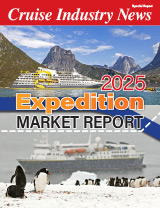 With seemingly more new rules and regulations being introduced and in the pipeline, Senior Vice President of Marine at Royal Caribbean International, William Wright said: “We react to new rules and regulations as we always have. This is nothing new; there have always been new rules coming down the pike, except that maybe the texture of the landscape is becoming more complicated.
With seemingly more new rules and regulations being introduced and in the pipeline, Senior Vice President of Marine at Royal Caribbean International, William Wright said: “We react to new rules and regulations as we always have. This is nothing new; there have always been new rules coming down the pike, except that maybe the texture of the landscape is becoming more complicated.
“Our objective has always been and will continue to be, having safe, reliable and compliant operations of our fleet. If we can do that, we are making our contribution to the product.”
Maintenance
While operating the biggest ships at sea, Wright said the focus is on guest satisfaction. Running small ships or large ships takes more or less the same amount of work, he said. The ships are basically the same, although with the new ships everything is on a bigger scale.
Reliable operations are achieved several ways, including preventive maintenance, which has always been practiced. A new buzz word is condition-based maintenance. “We continue to do preventive maintenance on all the main machinery and systems,” Wright explained, “and condition-based maintenance on components that are not critical. That means we can run some equipment until it breaks and then replace it, rather than overhauling or replacing it, according to manufacturers’ recommendations. A manufacturer may, for example, suggest overhaul or replacement every 5,000 hours for a component that can run 10,000 hours. As long as it is not a critical component, we are able to save both on labor and replacement costs.”
Royal Caribbean has also systems in place for remote monitoring of machinery and other equipment by those suppliers that offer such services, according to Wright. “We are able to see what is actually happening in real time.”
New Technology
The Oasis and Allure of the Seas, along with the Solstice-class ships of sister company Celebrity Cruises, are 20 percent more energy efficient than their predecessors, according to Wright, who attributed that to better hull design, propulsion and HVAC.
Royal Caribbean was also the first line to make a commitment to wastewater treatment, Wright said. “We have invested millions in helping to develop advanced wastewater treatment plants (AWP),” he said. “The technology did not exist,” he added. “Now, we are on the cutting edge of AWP technology and are in the process of installing it on all of our ships.” The end result is water that is near drinking-water quality.
As for ECAs (emission control areas), Wright said: “Right now, it really comes down to what kind of fuel you burn. We are testing scrubber technology and are hopeful that this may be a viable alternative solution at least on the large ships. If it is not viable, we have, of course, the option to burn cleaner fuel.”
Meanwhile, other new technologies are also being deployed, allowing, for instance, the company to monitor hull efficiency while ships are underway, Wright explained. “Optimizing trim can be very effective especially at higher speeds. Under 12 knots it has little impact. We are also able to monitor the roughness of the hull; there is a dramatic improvement in fuel consumption with a clean hull.”
Other efforts include minimizing waste from packaging, meaning less incineration, which also translates into reduced fuel consumption.
To be the Best They Can Be
Preparing for its big ships and worldwide deployment, Royal Caribbean bridge officers have been undergoing simulator training at Star Center in Florida replicating the bridge of the Voyager-class since 1999. “Our officers have been able to train not only on the human element aspects of bridge procedures, but also on the actual equipment,” Wright said, “learning about the capabilities and limitations of the equipment.”
“We are evaluating other training facilities or may do something on our own as well,” Wright continued.
“We are offering our officers the same level of training or better than other companies. Considering the business we are in and the size and complexity of our ships, we need to ensure that our officers are the best they can be. We carry the most valuable cargo there is.”
The key to running ships 24/7, Wright said, is “diligence, commitment and professionalism.”
Global Solutions
The world is without doubt becoming more complex. “But at the end of the day, stricter regulations help the environment,” Wright said, “and we support that. The company is used to dealing with and complying with regulations. It is the nature of the game.”
But all the rules and equipment may not be equally purposeful or effective. “Perceptions can sometimes be more important than reality,” Wright noted. One example is shorepower where Wright said it depends on where the power comes from. If the source is hydroelectric it makes sense, but other sources may be questionable in terms of transferring the emissions from ship to another location ashore.
Royal Caribbean is considering all future options, according to Wright, including fuel cells and LNG. As the company operates globally, it favors a global solution.
Excerpt from Cruise Industry News Quarterly Magazine: Winter 2010-2011



